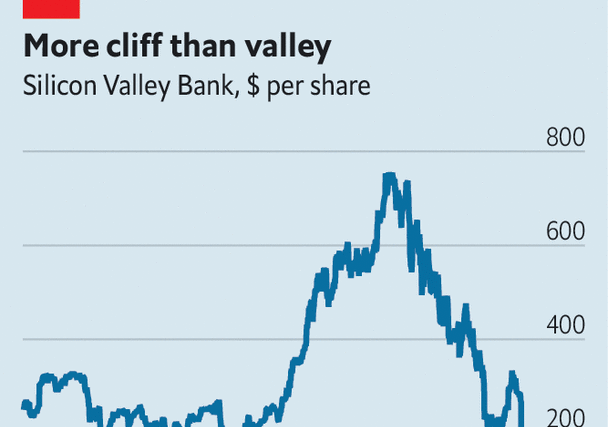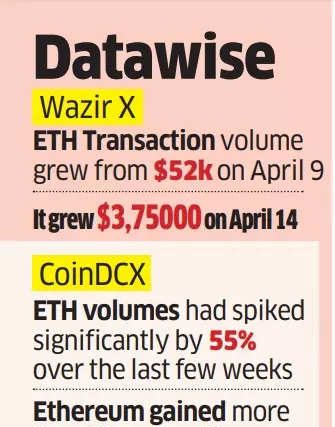Two ways. Gradually, then suddenly. That is how Silicon Valley Bank (svb), the 16th-largest lender in America, with about $200bn in assets, went bust. Its financial position deteriorated over several years. But just two days elapsed between the San Francisco-based bank’s announcement on March 8th that it was seeking to raise $2.5bn to plug a hole in its balance-sheet, and the declaration by the Federal Deposit Insurance Corporation, which regulates American bank deposits, that svb had failed.
svb’s share price plunged by 60% after the capital raise was revealed. Greg Becker, its chief executive, urged clients to “support us as we have supported you”. Unpersuaded, some venture capitalists told portfolio companies to run. Bill Ackman, a hedge-fund manager, suggested that the government should bail out the bank. By the morning of March 10th its shares had slid another 70% or so in pre-market trading, before a halt was called. cnbc, a television network, reported that svb’s capital-raising efforts had failed and that the bank was seeking to sell itself to a larger institution. Then came the announcement from the regulators.
These events raise two questions. The first is how svb got into this position. The second is whether its troubles are simply an anomaly, or a harbinger of doom for financial institutions writ large.
Start with the first. svb is a bank for startups. It opened accounts for them, often before larger lenders would bother. It also lent to them, which other banks are reluctant to do because few startups have assets for collateral. As Silicon Valley boomed over the past five years, so did svb. Its clients were flush with cash. They needed to store money more than to borrow.
Thus svb’s deposits more than quadrupled—from $44bn at the end of 2017 to $189bn at the end of 2021—while its loan book grew only from $23bn to $66bn. Since banks make money on the spread between the interest rate they pay on deposits (often nothing) and the rate they are paid by borrowers, having a far larger deposit base than loan book is a problem. svb needed to acquire other interest-bearing assets. By the end of 2021, the bank had made $128bn of investments, mostly into mortgage bonds and Treasuries.
Then the world changed. Interest rates soared as inflation became entrenched. This killed off the bonanza in venture capital and caused bond prices to plummet, leaving svb uniquely exposed. Its deposits had swollen when interest rates were low and its clients were flush with cash. Since the bank made investments during this time, it purchased bonds at their peak price. As venture-capital fundraising dried up, svb’s clients ran down their deposits: they fell from $189bn at the end of 2021 to $173bn at the end of 2022. svb was forced to sell off its entire liquid bond portfolio at lower prices than it paid. The losses it took on these sales, some $1.8bn, left a hole it tried to plug with the capital raise. When it went under the bank held some $91bn of investments, valued at their cost at the end of last year.
Were svb’s troubles an anomaly? The bank appears to have been uniquely susceptible to a run. Federal insurance, put in place after a series of panics that felled the American economy in the 1930s, covers deposits up to $250,000. This protects all the cash that most individuals would stash in a bank account. But it is unlikely to cover the funds a company would keep. svb is a bank not just for companies, but a narrow subsection of them that have suffered tougher times than most. Some 93% of its deposits were uninsured. Its customers, unlike those at most banks, had a real incentive to run—and they responded to it.
That said, nearly all banks are sitting on unrealised losses in their bond portfolios. If svb is the bank most likely to have been put in the position of having to stock up on bonds at their peak price, it is probably not the only one struggling with the whiplash in prices. Janet Yellen, the treasury secretary, says she is monitoring several banks in light of the events in Silicon Valley. Thankfully, loan books make up a much larger share of assets at most other institutions. And with rates rising, they are earning more.
The question now is whether there will be a bail-out and, if so, how big it would need to be to make depositors whole. svb “is the lifeblood of the tech ecosystem,” notes Ro Khanna, a congressman from California’s 17th district, which includes some of the valley. “They can’t let the bank fail. Whether that means that it should be acquired by another company…or get assistance from or even a statement from the Treasury department so that the depositors feel secure—I will leave that to the experts.”
Intervention would be unpopular. But short of stiffing depositors it may be the only option, since svb clearly did not hold enough to cover the losses it was being forced to take on assets. Larry Summers, a former treasury secretary, has said that so long as the state steps in, there is no reason to worry that svb will harm other parts of the financial system. Lots of people will be hoping that it does, and that he is right. ■




The Most Read
Сryptocurrencies
Bitcoin and Altcoins Trading Near Make-or-Break Levels
Financial crimes
Thieves targeted crypto execs and threatened their families in wide-ranging scheme
Financial crimes
Visa Warning: Hackers Ramp Up Card Stealing Attacks At Gas Stations
News
Capitalism is having an identity crisis – but it is still the best system
Uncategorized
The 73-year-old Vietnamese refugee is responsible for bringing Sriracha to American consumers
Uncategorized
Electric Truckmaker Rivian, Backed By Amazon, Ford, Raises Whopping $1.3 Billion